
(a)
Interpretation:
The product of the reaction of
Concept introduction:
Answer to Problem 11.46AP
The product of the reaction of

Explanation of Solution
The compound

Figure 1
The product of the reaction of
(b)
Interpretation:
The product of the reaction of
Concept introduction:
Epoxides undergo nucleophilic ring opening reactions which are base-catalyzed. If the epoxide is unsymmetrical, then the anionic nucleophile will attack the less-hindered carbon atom of the ring. If the reaction conditions are basic, then the reaction will occur at the less substituted carbon atom.
Answer to Problem 11.46AP
The product of the reaction of

Explanation of Solution
The compound

Figure 2
The product of the reaction of
(c)
Interpretation:
The product of the reaction of
Concept introduction:
Epoxides undergo nucleophilic ring-opening reactions which are base-catalyzed. If the epoxide is unsymmetrical, then the anionic nucleophile will attack the less-hindered carbon atom of the ring. If the reaction conditions are basic, then the reaction will occur at the less substituted carbon atom.
Answer to Problem 11.46AP
The product of the reaction of
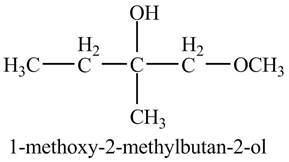
Explanation of Solution
The compound

Figure 3
The product of the reaction of
(d)
Interpretation:
The product of the reaction of
Concept introduction:
Epoxides undergo nucleophilic ring-opening reactions which are acid-catalyzed. If the epoxide is unsymmetrical, then the anionic nucleophile will attack the less-hindered carbon atom of the ring. If the reaction conditions are acidic, then the reaction will occur at the more substituted carbon atom.
Answer to Problem 11.46AP
The product of the reaction of
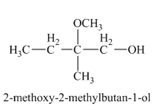
Explanation of Solution
The compound

Figure 4
The product of the reaction of
(e)
Interpretation:
The product of the reaction of
Concept introduction:
Epoxides undergo nucleophilic ring opening reactions which are acid-catalyzed. If the epoxide is unsymmetrical, then the anionic nucleophile will attack the less-hindered carbon atom of the ring. If the reaction conditions are acidic, then the reaction will occur at the more substituted carbon atom.
Answer to Problem 11.46AP
The product of the reaction of
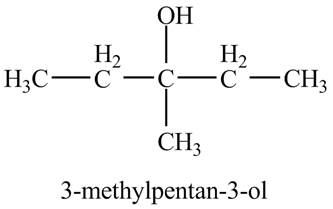
Explanation of Solution
The compound

Figure 5
The product of the reaction of
(f)
Interpretation:
The product of the reaction of the product of part (c) with
Concept introduction:
Epoxides undergo nucleophilic ring-opening reactions which are acid-catalyzed. If the epoxide is unsymmetrical, then the anionic nucleophile will attack the less-hindered carbon atom of the ring. If the reaction conditions are acidic, then the reaction will occur at the more substituted carbon atom.
Answer to Problem 11.46AP
The product of the reaction of the product of part (c) with
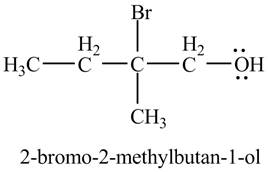
Explanation of Solution
In the presence of
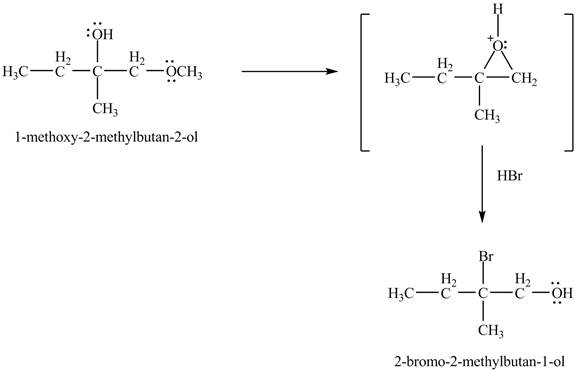
Figure 6
The product of the reaction of the given compound with
(g)
Interpretation:
The product of the reaction of the product of part (d) with
Concept introduction:
Epoxides undergo nucleophilic ring-opening reactions which are acid-catalyzed. If the epoxide is unsymmetrical, then the anionic nucleophile will attack the less-hindered carbon atom of the ring. If the reaction conditions are acidic, then the reaction will occur at the more substituted carbon atom.
Answer to Problem 11.46AP
The product of the reaction of the product of part (d) with
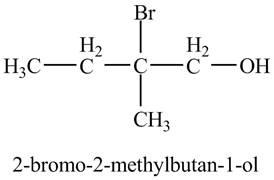
Explanation of Solution
In the presence of

Figure 7
The product of the reaction of the given compound with
(h)
Interpretation:
The product of the reaction of the product of part (c) with
Concept introduction:
The metal hydride reagents are good reducing agents such as
Answer to Problem 11.46AP
The product of the reaction of the product of part (c) with
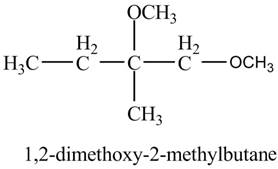
Explanation of Solution
The base

Figure 8
The product of the reaction of the given compound with
(i)
Interpretation:
The product of the reaction of the product of part (d) with
Concept introduction:
The metal hydride reagents are good reducing agents such as
Answer to Problem 11.46AP
The product of the reaction of the product of part (d) with
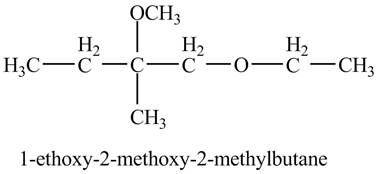
Explanation of Solution
The base

Figure 9
The product of the reaction of the given compound with
(j)
Interpretation:
The product of the reaction of the product of part (a) with periodic acid is to be predicted.
Concept introduction:
The periodic acid acts as a strong oxidizing agent. The periodic acid reacts with a vicinal diol to form two
Answer to Problem 11.46AP
The products of the reaction of the product of part (a) with periodic acid are shown below.

Explanation of Solution
The given compound is vicinal diol. It reacts with periodic acid to form two aldehydes. The carbon-carbon bond between the carbon atoms attached to two adjacent hydroxyl groups gets breaks. The corresponding chemical reaction is shown below.

Figure 10
The products of the reaction of the given compound with periodic acid are shown in Figure 10.
(k)
Interpretation:
The product of the reaction of the product of part (f) with
Concept introduction:
Grignard reagents are
Answer to Problem 11.46AP
The product of the reaction of the product of part (f) with
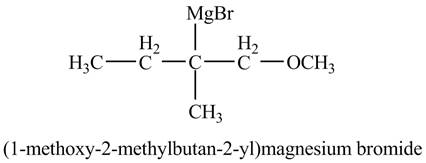
Explanation of Solution
The compound

Figure 11
The product of the reaction of the given compound with
(l)
Interpretation:
The product of the reaction of the product of part (k) with ethylene oxide followed by addition of
Concept introduction:
Grignard reagents are organometallic compounds which are prepared using alkyl halides in the presence of magnesium metal in dry ether. These reagents act as strong nucleophiles and bases. Grignard reagents react with carbonyl compounds to form alcohol.
Answer to Problem 11.46AP
The product of the reaction of the product of part (k) with ethylene oxide followed by addition of
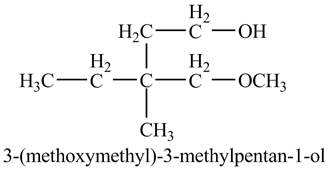
Explanation of Solution
Grignard reagent can act as a nucleophile. In the presence of an acid, it can attack the more substituted carbon atom of the epoxy ring. The Grignard reagent reacts with the ethylene oxide followed by protonolysis to form alcohol. The corresponding chemical reaction is shown below.

Figure 12
The product of the reaction of the given compound with ethylene oxide followed by addition of
Want to see more full solutions like this?
Chapter 11 Solutions
Organic Chemistry, Ebook And Single-course Homework Access
- The reaction of solid dimethylhydrazine, (CH3)2N2H2, and liquefied dinitrogen tetroxide, N2O4, has been investigated for use as rocket fuel. The reaction produces the gases carbon dioxide (CO2), nitrogen (N2), and water vapor (H2O), which are ejected in the exhaust gases. In a controlled experiment, solid dimethylhydrazine was reacted with excess dinitrogen tetroxide, and the gases were collected in a closed balloon until a pressure of 2.50 atm and a temperature of 400.0 K were reached.(a) What are the partial pressures of CO2, N2, and H2O?(b) When the CO2 is removed by chemical reaction, what are the partial pressures of the remaining gases?arrow_forwardOne liter of chlorine gas at 1 atm and 298 K reacts completely with 1.00 L of nitrogen gas and 2.00 L of oxygen gas at the same temperature and pressure. A single gaseous product is formed, which fills a 2.00 L flask at 1.00 atm and 298 K. Use this information to determine the following characteristics of the product:(a) its empirical formula;(b) its molecular formula;(c) the most favorable Lewis formula based on formal charge arguments (the central atom is N);(d) the shape of the molecule.arrow_forwardHow does the square root mean square velocity of gas molecules vary with temperature? Illustrate this relationship by plotting the square root mean square velocity of N2 molecules as a function of temperature from T=100 K to T=300 K.arrow_forward
- Draw product B, indicating what type of reaction occurs. F3C CF3 NH2 Me O .N. + B OMearrow_forwardBenzimidazole E. State its formula. sState the differences in the formula with other benzimidazoles.arrow_forwardDraw product A, indicating what type of reaction occurs. F3C CN CF3 K2CO3, DMSO, H₂O2 Aarrow_forward
- 19) Which metal is most commonly used in galvanization to protect steel structures from oxidation? Lead a. b. Tin C. Nickel d. Zinc 20) The following molecule is an example of a: R₁ R2- -N-R3 a. Secondary amine b. Secondary amide c. Tertiary amine d. Tertiary amidearrow_forwardpls helparrow_forwardIndicate the product of the reaction OH OH CH3-CC- Ph + H2SO4 a 20°C | CH3 Pharrow_forward
